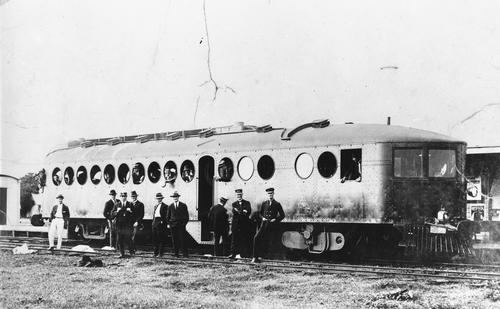Number built 152 | Constructed 1914 | |
 | ||
Car length 55 ft (16.76 m) and 70 ft (21.34 m) | ||
The McKeen Railmotor was a 6-cylinder self-propelled railcar. When McKeen Company of Omaha, Nebraska, U.S.A. first unveiled the car in 1905, the McKeen was among the first engines with a gasoline-powered motor. Revisions to the McKeen car led to the modern self-propelled gasoline rail-motor vehicle, and the "contours of the porthole windows, the front-mounted gasoline engines, and other features anticipated the streamline concept."
Contents
Design
William R. McKeen was the superintendent of motive power and machinery at Union Pacific Railroad in 1904 when Edward H. Harriman, the head of UP, began encouraging him to develop the machine. The result of his experiments that year was a "knife-nosed" or "windsplitter" unit that slightly resembled a submarine on wheels, having a distinctive pointed nose, a rounded rear end, center-entry doors and porthole windows. Two lengths, 55 and 70 feet (16.76 and 21.34 m), were offered, and both could be configured with either a large mail and express area ahead of the center doors, a smaller mail and express area, or fully fitted with seats, which provided a maximum passenger capacity of 64 or 105 respectively. Cheaper and more powerful than battery-powered vehicles, the McKeen was more flexible than steam locomotives and could operate at competitive speeds.
United States
The McKeen was popular from 1915 through the 1930s throughout the United States, and the cars were featured on the Union Pacific and the Southern Pacific.
Victoria, Australia
Two McKeen railmotors were purchased and delivered to the Victorian Railways in Victoria, Australia in 1911. They served throughout their life as a railmotor they ran the Ballarat to Maryborough and Hamilton to Warrnambool services, and briefly in March and April 1913 on Maryborough to St Arnaud services.
The railmotors had a poor record with many breakdowns, they only lasted around 3 years as railmotors. In 1919 they were de-engined and converted to passenger cars numbered as 1 & 2 ABCL for use on the Altona line until they were scrapped in August 1926.
Queensland, Australia
In June, 1911, Queensland Railways ordered five self-propelled rail cars from the McKeen Motor Co of Omaha, Nebraska, USA, at a cost of £4500 per unit. They were delivered in May, 1913. Originally seating capacity was 75; this was later reduced to 69, 55 in the main section and 14 in the "smoker". Although popular on the United States Union Pacific and Southern Railroads, the McKeen Cars failed to meet QR's expectations. All five units were written off between 1929 and 1931 and broken up soon after at the Ipswich workshops.
Withdrawal
The Nevada State Railroad Museum completed the restoration of McKeen car, #22 of the Virginia and Truckee Railroad, a 70-foot (21.34 m) car by 05/09/2010. The original powerplant did not survive, but it was replaced with a modern engine and drive system to allow the car to transport visitors to the museum around its short track.
